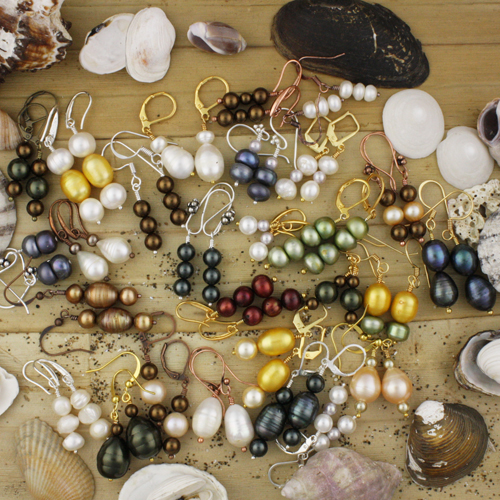The Three Types of Pearls I Use In My Jewelry
Posted by Denise Hershey on Aug 2nd 2017
![]()
Natural pearls have been prized since antiquity for their lustrous beauty as well as their rarity. Only mollusks can produce pearls, and only a few specific clams produce pearls we cherish today, the rest being generally unsuitable for jewelry or collections because they are not durable and beautiful in shape and color.
Per Wikipedia: https://en.wikipedia.org/wiki/Pearl: “The unique luster of pearls depends upon the reflection, refraction, and diffraction of light from the translucent layers. The thinner and more numerous the layers in the pearl, the finer the luster. The iridescence that pearls display is caused by the overlapping of successive layers, which breaks up light falling on the surface.
![]() In addition, pearls (especially cultured freshwater pearls) can be dyed yellow, green, blue, brown, pink,
In addition, pearls (especially cultured freshwater pearls) can be dyed yellow, green, blue, brown, pink,
purple, or black. The very best pearls have a metallic mirror-like luster.”
![]() It wasn’t until about 100 years ago, that British Biologist William Saville-Kent developed the
current process of pearl culture in Australia and
brought to Japan by Tokichi Nishikawa and Tatsuhei Mise. Saville-Kent’s
patent was granted in 1916, and slowly matured until it was the predominant pearl
in jewelry making pearls affordable to common people.
It wasn’t until about 100 years ago, that British Biologist William Saville-Kent developed the
current process of pearl culture in Australia and
brought to Japan by Tokichi Nishikawa and Tatsuhei Mise. Saville-Kent’s
patent was granted in 1916, and slowly matured until it was the predominant pearl
in jewelry making pearls affordable to common people.
Natural pearls are divided into salt-water and fresh-water pearls. Further they are divided by the species of mollusk that produces them, as well as the location. These differences create a wide variety of shapes and colors of pearls.
Both salt- and fresh-water natural pearls are formed by the same biological functions. If the mollusk has been damaged or invaded by an irritant such as a parasite, as a defense, the mollusk creates a pearl sac around the irritant which keeps it from damaging the rest of the animal. Inside the pearl sac, the irritant is covered with successive layers of “nacre” which is the ingredient that forms the mother of pearl inside of the shell.

Per Wikipedia: https://en.wikipedia.org/wiki/Pearl: “The mollusk's mantle (protective membrane) deposits layers of calcium carbonate(CaCO3) in the form of the mineral aragonite or a mixture of aragonite and calcite (polymorphs with the same chemical formula, but different crystal structures) held together by an organic horn-like compound called conchiolin. The combination of aragonite and conchiolin is called nacre, which makes up mother-of-pearl.”
Natural pearls are still rare and expensive. Most jewelry uses affordable “cultured” or “imitation” pearls. Freshwater cultured pearls are created when a piece of the mantle of a donor mollusk is grafted into a living mollusk. This is the irritant which over time becomes a cultured pearl. If you x-ray one, you will see a void in the center where the starting material was with layers of nacre surrounding it. Some salt-water pearls are created in the same “bead-less cultured” way. Most salt-water pearls are started with the piece of mantle affixed to a bead. These “nucleated cultured pearl” beads can be formed from the shells of mollusks, or of another material.
Imitation pearls skip the mollusk process. They can be mother of pearl shell fragments formed into a bead, or they can be a bead made of man-made material like plastic or glass that has been coated with a material that looks similar to the luster of nacre.
![]()
Per Wikipedia: https://en.wikipedia.org/wiki/Pearl: “Some imitation pearls (also called shell pearls) are simply made of mother-of-pearl, coral or conch shell, while others are made from glass and are coated with a solution containing fish scales called essence d'Orient. Although imitation pearls look the part, they do not have the same weight or smoothness as real pearls, and their luster will also dim greatly." See https://en.wikipedia.org/wiki/Imitation_pearl for more information on imitation pearls.
Per Wikipedia: https://en.wikipedia.org/wiki/Pearl: “The GIA and CIBJO now simply use the term 'pearl' (or, where appropriate, the more descriptive term 'non-nacreous pearl') when referring to [other mollusk pearls] and, under Federal Trade Commission rules, various mollusk pearls may be referred to as 'pearls', without qualification.“ Imitation pearls are not considered cultured pearls.

Cultured and imitation pearls can be dyed in other colors. I mostly use both uncolored and colored cultured pearls in my jewelry. I sometimes use smaller colored imitation pearls to keep the price affordable. When I choose pearls for my jewelry, I embrace the imperfections of the “baroque” cultured pearls. These are the lowest quality shape of pearls, but are beautiful in their own way. When knotted into a strand, they form an interesting chain of irregular pieces. I also mix in round cultured or imitation pearls in patterns and colors to create an interesting arrangement or progression of shape and color. In this way, I create lovely affordable pearl necklaces that can be worn for any occasion whether formal or informal.
Join the Newsletter if you haven't already and then go shopping in the menu above.
